Norbert Oswald
synth-dacl: Does Synthetic Defect Data Enhance Segmentation Accuracy and Robustness for Real-World Bridge Inspections?
Jun 17, 2025Abstract:Adequate bridge inspection is increasingly challenging in many countries due to growing ailing stocks, compounded with a lack of staff and financial resources. Automating the key task of visual bridge inspection, classification of defects and building components on pixel level, improves efficiency, increases accuracy and enhances safety in the inspection process and resulting building assessment. Models overtaking this task must cope with an assortment of real-world conditions. They must be robust to variations in image quality, as well as background texture, as defects often appear on surfaces of diverse texture and degree of weathering. dacl10k is the largest and most diverse dataset for real-world concrete bridge inspections. However, the dataset exhibits class imbalance, which leads to notably poor model performance particularly when segmenting fine-grained classes such as cracks and cavities. This work introduces "synth-dacl", a compilation of three novel dataset extensions based on synthetic concrete textures. These extensions are designed to balance class distribution in dacl10k and enhance model performance, especially for crack and cavity segmentation. When incorporating the synth-dacl extensions, we observe substantial improvements in model robustness across 15 perturbed test sets. Notably, on the perturbed test set, a model trained on dacl10k combined with all synthetic extensions achieves a 2% increase in mean IoU, F1 score, Recall, and Precision compared to the same model trained solely on dacl10k.
Locality-Sensitive Hashing for Efficient Hard Negative Sampling in Contrastive Learning
May 23, 2025Abstract:Contrastive learning is a representational learning paradigm in which a neural network maps data elements to feature vectors. It improves the feature space by forming lots with an anchor and examples that are either positive or negative based on class similarity. Hard negative examples, which are close to the anchor in the feature space but from a different class, improve learning performance. Finding such examples of high quality efficiently in large, high-dimensional datasets is computationally challenging. In this paper, we propose a GPU-friendly Locality-Sensitive Hashing (LSH) scheme that quantizes real-valued feature vectors into binary representations for approximate nearest neighbor search. We investigate its theoretical properties and evaluate it on several datasets from textual and visual domain. Our approach achieves comparable or better performance while requiring significantly less computation than existing hard negative mining strategies.
SoccerNet 2024 Challenges Results
Sep 16, 2024
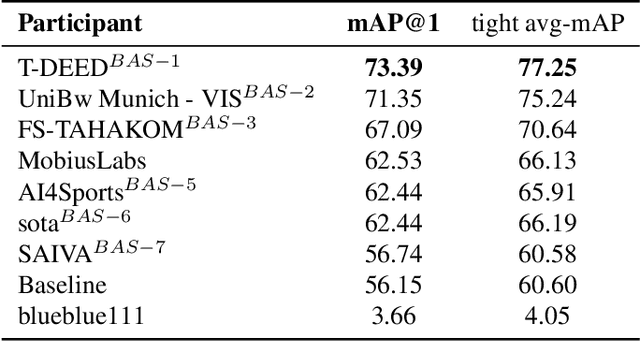
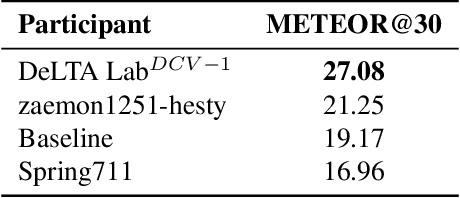
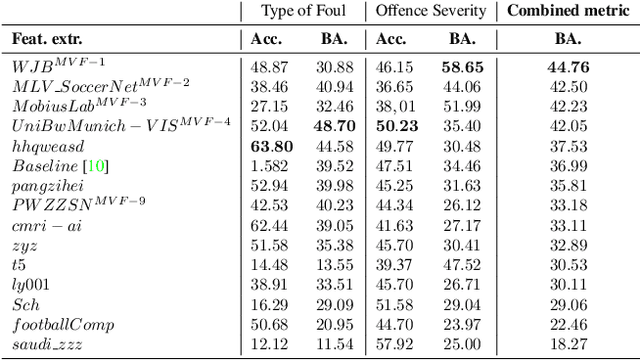
Abstract:The SoccerNet 2024 challenges represent the fourth annual video understanding challenges organized by the SoccerNet team. These challenges aim to advance research across multiple themes in football, including broadcast video understanding, field understanding, and player understanding. This year, the challenges encompass four vision-based tasks. (1) Ball Action Spotting, focusing on precisely localizing when and which soccer actions related to the ball occur, (2) Dense Video Captioning, focusing on describing the broadcast with natural language and anchored timestamps, (3) Multi-View Foul Recognition, a novel task focusing on analyzing multiple viewpoints of a potential foul incident to classify whether a foul occurred and assess its severity, (4) Game State Reconstruction, another novel task focusing on reconstructing the game state from broadcast videos onto a 2D top-view map of the field. Detailed information about the tasks, challenges, and leaderboards can be found at https://www.soccer-net.org, with baselines and development kits available at https://github.com/SoccerNet.
Unimodal Multi-Task Fusion for Emotional Mimicry Prediction
Mar 22, 2024Abstract:In this study, we propose a methodology for the Emotional Mimicry Intensity (EMI) Estimation task within the context of the 6th Workshop and Competition on Affective Behavior Analysis in-the-wild. Our approach leverages the Wav2Vec 2.0 framework, pre-trained on a comprehensive podcast dataset, to extract a broad range of audio features encompassing both linguistic and paralinguistic elements. We enhance feature representation through a fusion technique that integrates individual features with a global mean vector, introducing global contextual insights into our analysis. Additionally, we incorporate a pre-trained valence-arousal-dominance (VAD) module from the Wav2Vec 2.0 model. Our fusion employs a Long Short-Term Memory (LSTM) architecture for efficient temporal analysis of audio data. Utilizing only the provided audio data, our approach demonstrates significant improvements over the established baseline.
Enhancing Conceptual Understanding in Multimodal Contrastive Learning through Hard Negative Samples
Mar 05, 2024Abstract:Current multimodal models leveraging contrastive learning often face limitations in developing fine-grained conceptual understanding. This is due to random negative samples during pretraining, causing almost exclusively very dissimilar concepts to be compared in the loss function. Consequently, the models struggle with fine-grained semantic differences. To address this problem, we introduce a novel pretraining method incorporating synthetic hard negative text examples. The hard negatives permute terms corresponding to visual concepts, leading to a more fine-grained visual and textual concept alignment. Further, we introduce InpaintCOCO, a new challenging dataset for assessing the fine-grained alignment of colors, objects, and sizes in vision-language models. We created the dataset using generative inpainting from COCO images by changing the visual concepts so that the images no longer match their original captions. Our results show significant improvements in fine-grained concept understanding across a wide range of vision-language datasets, including our InpaintCOCO dataset.
SoccerNet 2023 Challenges Results
Sep 12, 2023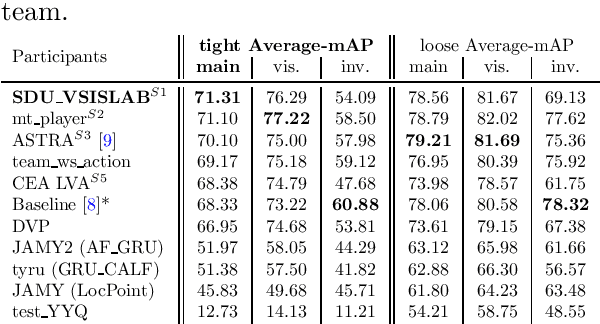


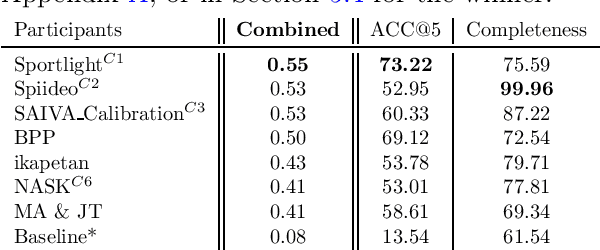
Abstract:The SoccerNet 2023 challenges were the third annual video understanding challenges organized by the SoccerNet team. For this third edition, the challenges were composed of seven vision-based tasks split into three main themes. The first theme, broadcast video understanding, is composed of three high-level tasks related to describing events occurring in the video broadcasts: (1) action spotting, focusing on retrieving all timestamps related to global actions in soccer, (2) ball action spotting, focusing on retrieving all timestamps related to the soccer ball change of state, and (3) dense video captioning, focusing on describing the broadcast with natural language and anchored timestamps. The second theme, field understanding, relates to the single task of (4) camera calibration, focusing on retrieving the intrinsic and extrinsic camera parameters from images. The third and last theme, player understanding, is composed of three low-level tasks related to extracting information about the players: (5) re-identification, focusing on retrieving the same players across multiple views, (6) multiple object tracking, focusing on tracking players and the ball through unedited video streams, and (7) jersey number recognition, focusing on recognizing the jersey number of players from tracklets. Compared to the previous editions of the SoccerNet challenges, tasks (2-3-7) are novel, including new annotations and data, task (4) was enhanced with more data and annotations, and task (6) now focuses on end-to-end approaches. More information on the tasks, challenges, and leaderboards are available on https://www.soccer-net.org. Baselines and development kits can be found on https://github.com/SoccerNet.
dacl1k: Real-World Bridge Damage Dataset Putting Open-Source Data to the Test
Sep 07, 2023Abstract:Recognising reinforced concrete defects (RCDs) is a crucial element for determining the structural integrity, traffic safety and durability of bridges. However, most of the existing datasets in the RCD domain are derived from a small number of bridges acquired in specific camera poses, lighting conditions and with fixed hardware. These limitations question the usability of models trained on such open-source data in real-world scenarios. We address this problem by testing such models on our "dacl1k" dataset, a highly diverse RCD dataset for multi-label classification based on building inspections including 1,474 images. Thereby, we trained the models on different combinations of open-source data (meta datasets) which were subsequently evaluated both extrinsically and intrinsically. During extrinsic evaluation, we report metrics on dacl1k and the meta datasets. The performance analysis on dacl1k shows practical usability of the meta data, where the best model shows an Exact Match Ratio of 32%. Additionally, we conduct an intrinsic evaluation by clustering the bottleneck features of the best model derived from the extrinsic evaluation in order to find out, if the model has learned distinguishing datasets or the classes (RCDs) which is the aspired goal. The dacl1k dataset and our trained models will be made publicly available, enabling researchers and practitioners to put their models to the real-world test.
Orientation-Guided Contrastive Learning for UAV-View Geo-Localisation
Aug 02, 2023



Abstract:Retrieving relevant multimedia content is one of the main problems in a world that is increasingly data-driven. With the proliferation of drones, high quality aerial footage is now available to a wide audience for the first time. Integrating this footage into applications can enable GPS-less geo-localisation or location correction. In this paper, we present an orientation-guided training framework for UAV-view geo-localisation. Through hierarchical localisation orientations of the UAV images are estimated in relation to the satellite imagery. We propose a lightweight prediction module for these pseudo labels which predicts the orientation between the different views based on the contrastive learned embeddings. We experimentally demonstrate that this prediction supports the training and outperforms previous approaches. The extracted pseudo-labels also enable aligned rotation of the satellite image as augmentation to further strengthen the generalisation. During inference, we no longer need this orientation module, which means that no additional computations are required. We achieve state-of-the-art results on both the University-1652 and University-160k datasets.
CLIP-ReIdent: Contrastive Training for Player Re-Identification
Mar 21, 2023Abstract:Sports analytics benefits from recent advances in machine learning providing a competitive advantage for teams or individuals. One important task in this context is the performance measurement of individual players to provide reports and log files for subsequent analysis. During sport events like basketball, this involves the re-identification of players during a match either from multiple camera viewpoints or from a single camera viewpoint at different times. In this work, we investigate whether it is possible to transfer the out-standing zero-shot performance of pre-trained CLIP models to the domain of player re-identification. For this purpose we reformulate the contrastive language-to-image pre-training approach from CLIP to a contrastive image-to-image training approach using the InfoNCE loss as training objective. Unlike previous work, our approach is entirely class-agnostic and benefits from large-scale pre-training. With a fine-tuned CLIP ViT-L/14 model we achieve 98.44 % mAP on the MMSports 2022 Player Re-Identification challenge. Furthermore we show that the CLIP Vision Transformers have already strong OCR capabilities to identify useful player features like shirt numbers in a zero-shot manner without any fine-tuning on the dataset. By applying the Score-CAM algorithm we visualise the most important image regions that our fine-tuned model identifies when calculating the similarity score between two images of a player.
Sample4Geo: Hard Negative Sampling For Cross-View Geo-Localisation
Mar 21, 2023Abstract:Cross-View Geo-Localisation is still a challenging task where additional modules, specific pre-processing or zooming strategies are necessary to determine accurate positions of images. Since different views have different geometries, pre-processing like polar transformation helps to merge them. However, this results in distorted images which then have to be rectified. Adding hard negatives to the training batch could improve the overall performance but with the default loss functions in geo-localisation it is difficult to include them. In this article, we present a simplified but effective architecture based on contrastive learning with symmetric InfoNCE loss that outperforms current state-of-the-art results. Our framework consists of a narrow training pipeline that eliminates the need of using aggregation modules, avoids further pre-processing steps and even increases the generalisation capability of the model to unknown regions. We introduce two types of sampling strategies for hard negatives. The first explicitly exploits geographically neighboring locations to provide a good starting point. The second leverages the visual similarity between the image embeddings in order to mine hard negative samples. Our work shows excellent performance on common cross-view datasets like CVUSA, CVACT, University-1652 and VIGOR. A comparison between cross-area and same-area settings demonstrate the good generalisation capability of our model.
 Add to Chrome
Add to Chrome Add to Firefox
Add to Firefox Add to Edge
Add to Edge